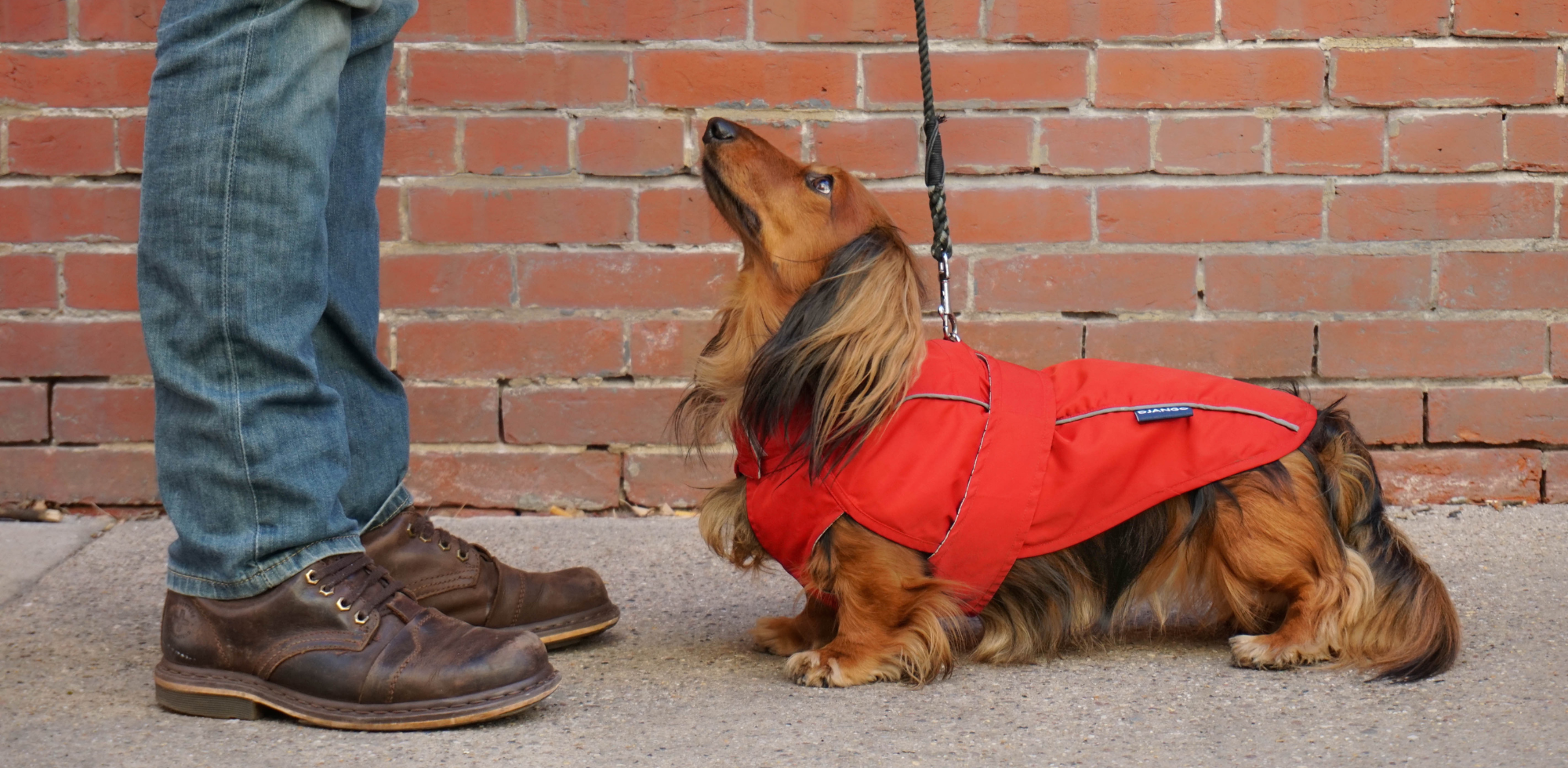A few months ago, one of my good girlfriends told me (Steph) that her dachshund Oreo was diagnosed with advancing heart disease. Although her dog was only a few years old, he grew lethargic and seemed to have difficulty keeping up on his daily walk in downtown Philadelphia. One weekday morning, Oreo suddenly collapsed during a short and relaxed morning walk. Trips to the emergency veterinarian and a canine cardiologist unfortunately confirmed that Oreo was suffering from advancing heart disease caused by a congenital heart defect.
Congenital heart disease refers to heart defects that are congenital, or present from birth. Although only 1-1.5% of dogs are affected by congenital heart disease, congenital heart defects can lead to irreversible heart damage and heart failure if not diagnosed and treated successfully. They are also not covered by pet insurance and can cost thousands of dollars to treat. With this in mind, it is important for all dog owners, new and experienced, to be aware of congenital heart defects and their symptoms.
What congenital heart defects are most common, and what are their symptoms? What dog breeds are most at risk of congenital heart defects, and how might they affect life expectancy? Can dogs with congenital heart defects be successfully treated, and how much does treatment cost? Is there any way to prevent these heart defects in dogs?
Here is everything you need to know about the causes, symptoms, treatment, and prevention of congenital heart disease in dogs.
CONGENITAL HEART DISEASE IN DOGS
There are three types of congenital heart disease most commonly found in dogs: pulmonic stenosis, patent ductus arteriosus, and subaortic stenosis.
PULMONIC STENOSIS
Pulmonic stenosis is the most common congenital heart defect found in dogs. A 2020 study examined the medical records of dogs with congenital heart disease over a decade. More than one-third of the dogs suffered from pulmonic stenosis.
Your dog’s heart has strong, thin flaps of tissue called cusps. Cusps open and close. When open, they let blood move forward through the heart. When closed, they prevent blood from flowing back into the heart. Pulmonic stenosis happens when the pulmonary valve’s cusps are too thick or fused together. To move blood through the thick/fused cusps, your dog's heart has to pump harder. This increase in pressure causes the right side of the heart to grow enlarged. Over time, this can lead to rhythm disturbances and congestive heart failure.
AFFECTED BREEDS
Pulmonic stenosis is most common in purebred male dogs. The breeds most susceptible to pulmonic stenosis include cocker spaniels, Chihuahuas, beagles, English bulldogs, miniature schnauzers, Samoyeds, mastiffs, basset hounds, French bulldogs, and terriers (i.e., Airedale, West Highland white, Scottish, wire fox, and Yorkshire).
LIFE EXPECTANCY
The life expectancy of dogs with pulmonic stenosis is estimated by the pressure within the heart's pulmonary valve. According to Missouri University’s Veterinary Health Center, normal canine pulmonary valve pressure is 25/10 millimeters of mercury (mm Hg). Dogs with pulmonic stenosis have pressures greater than 50mmHg.
Mild stenosis: Pressure < 50 mmHg
In most cases, dogs have normal lifespans and do not require therapy. Clinical signs and symptoms (see below) may never be observed throughout the dog's life.
Moderate stenosis: Pressure > 50 mmHg and < 80 mmHg
Dogs with moderate pulmonic stenosis usually have normal life spans, but they may experience symptoms that require medical therapy.
Severe stenosis: Pressure > 80 mmHg
Dogs with severe pulmonic stenosis are 16 times more likely to suddenly pass away, according to the Journal of Veterinary Internal Medicine. Nearly 35% of dogs with severe pulmonic stenosis are unfortunately put down because of chronic heart failure.
PATENT DUCTUS ARTERIOSUS
Patent ductus arteriosus is caused when the ductus arteriosus—a blood vessel connecting the pulmonary artery and aorta—does not close after birth.
When your puppy is born, his first breath fills his lungs with oxygen. This causes the ductus arteriosus, which is lined with muscles, to close almost immediately.
If the ductus arteriosus remains open, oxygen-rich blood gets dumped back into your dog’s pulmonary artery. Pressure increases to the point that fluid starts to leak into the lungs. This leads to left-sided congestive heart failure.
AFFECTED BREEDS
According to a 2011 study, patent ductus arteriosus is most common in purebred female dogs. Maltese, Pomeranians, Shetland sheepdogs, and Kerry blue terriers are most often affected. Patent ductus arteriosus has also been described in higher incidences in Chihuahuas, bichon frises, English springer spaniels, collies, toy/miniature poodles, cocker spaniels, German shepherds, Irish setters, and Yorkshire terriers.
LIFE EXPECTANCY
Patent ductus arteriosus is curable even if when treated later in life. In most cases, a veterinary cardiologist will correct patent ductus arteriosus within the first 6 to 12 months of life. Without surgery, two-thirds of affected puppies will pass away before they are a year old.
SUBAORTIC STENOSIS
Subaortic stenosis is the third most common congenital heart defect in dogs and is caused by a fibrous ring of abnormal tissue below the aortic valve. The tissue blocks blood from flowing smoothly through the heart, ultimately forcing the left ventricular to pump blood at a higher speed and pressure. Excessive pressure causes the left ventricular to thicken and enlarge over time. This can disrupt the heart's normal rhythm and lead to fainting spells or even sudden death.
AFFECTED BREEDS
Subaortic stenosis is most common in purebred male dogs. It is also more prevalent in large dog breeds, such as German shepherds, golden retrievers, Rottweilers, Newfoundlands, Great Danes, boxers, dogue de Bordeaux, and German short-haired pointers.
LIFE EXPECTANCY
Dogs with mild subaortic stenosis have normal lifespans and usually do not have any symptoms. The majority of dogs with moderate or severe subaortic stenosis pass away before 3 years of age. A 2015 study found that the average life expectancy is 18 months.
SYMPTOMS OF CONGENITAL HEART DISEASE IN DOGS
Clinical signs and symptoms of canine congenital heart disease can range from mild to severe and include:
- Loud/continuous heart murmur
- Stunted growth
- Weakness
- Depression
- Coughing
- Difficulty breathing (Dyspnea)
- Fluid in the lungs (Pulmonary edema)
- Exercise intolerance
- Fainting
- Irregular/weak pulse
- High red blood cell count (polycythemia)
- A buildup of fluid in the belly (Ascites)
- Bluish paws on the hind legs
- Collapse
- Seizures
- Congestive heart failure
- Sudden cardiac death
According to the Journal of Small Animal Practices, 75% of dogs with congenital heart disease do not have any symptoms.
“MY DOG WAS DIAGNOSED WITH A HEART MURMUR. DOES HE HAVE A CONGENITAL HEART DISEASE?
A heart murmur does not mean that your dog has a congenital heart defect. It is common for young puppies to have an innocent heart murmur while they are rapidly growing. Innocent heart murmurs usually appear at 6 to 8 weeks of age and disappear by 4 or 5 months of age. If your dog’s heart murmur is continuous, still present after 6 months, or heard best on the right, please consult your veterinarian as soon as possible.
HOW IS CONGENITAL HEART DISEASE IN DOGS DIAGNOSED?
There are several ways congenital heart defects in dogs are diagnosed:
- Routine exam. Most congenital heart defects are discovered during routine annual exams when a heart murmur is detected. Routine annual exams typically average $45-55 according to CareCredit.
- A patent ductus arteriosus murmur sounds like a washing machine because it is loud and continuous. It is easiest to hear when the stethoscope is placed in your dog’s left “armpit”.
- Pulmonic stenosis and subaortic stenosis murmurs are systolic and best heard at the base of your dog’s heart.
- Angiograms. During an angiogram, a long narrow tube called a catheter is inserted into an artery or vein in your dog’s arm, neck, or groin. Then it is threaded through a blood vessel until it reaches his heart. Using a special X-ray machine and injectable contrast dye, an angiogram shows your dog’s valves, coronary arteries, and heart chambers. It may cost $500 to $1,000.
- Chest x-rays. Chest x-rays can determine the size and the shape of your dog’s heart. They can also show fluid buildup in his lung tissue. The average cost of a canine chest x-ray is about $150 to $250.
- Echocardiograms (also known as cardiac ultrasounds). Echocardiograms can measure the diameter and thickness of your dog’s heart chambers. Used with Doppler ultrasound, they can also show narrow or blocked heart valves and blood flow patterns. Echocardiograms can cost as much as $500 to $600 each.
- Electrocardiogram (EKG). EKGs measure the electric currents created by your dog’s heart. They also tell how fast it is beating and if that rhythm is normal. An EKG costs on average $65 in the U.S.
TREATMENT OF CONGENITAL HEART DISEASE IN DOGS
- Balloon valvuloplasty. Balloon valvuloplasty is a minimally-invasive surgical procedure. Once your dog is put under, a catheter is threaded into his heart. It has a tough balloon at the end. When the balloon is inflated, it breaks down the scarring and opens the aortic or pulmonary valve. Balloon valvuloplasty costs $5,000 to $10,000.
- Catheter-based occlusion. Catheter-based occlusion is a minimally-invasive surgical procedure. Coils or a ductal occluder are positioned inside two major blood vessels. They cause a clot to form around them, plugging up the patent ductus arteriosus. Catheter-based occlusion may not work for smaller dog breeds.
- Diuretics and angiotensin-converting enzyme inhibitors (ACE inhibitors). Diuretics (i.e., furosemide and spironolactone) and ACE inhibitors (e.g., benazepril, enalapril, imidapril, and ramipril) are used to help pull fluid out of your dog’s lungs. A 30-day supply of furosemide for a 14-pound dachshund like our little guy Django costs $4.20 (14¢ per 12.5 mg capsule).
- Beta-blockers. Beta-blockers (e.g., atenolol, metoprolol, or carvedilol) are used to slow down your dog’s pulse and allow his heart more time to fill with blood. Side effects include lethargy, depression, low blood pressure, low blood sugar, collapse, and difficulty breathing. A 6-month supply is $27.45 (15¢ per 50 mg capsule).
- Exercise restriction. If your dog has moderate or severe subaortic stenosis, his exercise should be restricted. Demanding exercises (particularly in warm weather) can cause fainting, collapse, or even sudden death.
- Open heart surgery (also known as a thoracotomy). Open heart surgery is an invasive surgical procedure that is used to treat patent ductus arteriosus. After your dog’s chest is opened, a piece of suture is used to tie off the patent ductus. Open heart surgery has a 70% survival rate and typically costs between $10,000 and $18,000.
HOW TO PREVENT CONGENITAL HEART DISEASE IN DOGS
Because congenital heart defects are present at birth, there is no way to prevent them during the dog's lifespan. Rather, congenital heart disease can be best prevented through responsible dog breeding.
At-risk dog breeds should have a full cardiac workup before breeding. While a typical cardiac work-up ranges from $625 to $1000, the bill is obviously worth it if a congenital heart defect is detected and prevented from being passed down to future offspring. The siblings and parents of dogs with congenital heart defects also should be spayed or neutered.
BEFORE YOU GO
We hope you found this DJANGO Dog Blog post informative and useful and would love to hear from you. If you have any comments, questions, or want to share an experience with our dog-loving readers, please leave a comment below!




